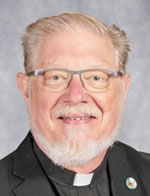That All May Be One / Fr. Rick Ginther
Overcoming polarization to build on our ecumenical, interreligious dialogue
 Polarization. We live in a vast pool of it.
Polarization. We live in a vast pool of it.
We are drained of creative, life-giving energy by the creatures within this pool: “them vs. us” and “either/or.”
We seem to have forgotten the wisdom of the Book of Ecclesiastes in chapter 3: “There is an appointed time for everything, and a time for every affair under the heavens: a time to be born and a time to die” (Eccl 3:1-2).
The juxtapositions Qoheleth lays out are not “either/or.” They are “both/and” aspects of our human reality.
When we recognize the tension between them, we discover creative living and coping that guide us. We find a way to face the complexities of life, acknowledging the wisdom in each moment between each terminus.
Ecumenical and interreligious dialogue (formal or informal) is difficult in a polarized world.
Ecumenical means “universal”—taking in the whole of the world’s peoples. We apply it today to the universal world of Christians.
Interreligious means “among all religions.” Not just some (e.g., Abrahamic). No, all religions.
There are more than 40,000 variants of Christianity in the world today. They have a common origin: belief in the person of Christ. A common book: the Bible. And a common longing: redemption and salvation.
But the Christian variants are not the same. Some emerged through cultural and linguistic differences that developed between societies in the eastern and western Mediterranean in the first millennium of the Church. These resulted in a formal split in the 11th century between Christians in the east (Orthodox) and those in the west (Catholic).
And the splintering continues.
The other religions of the world are numerous, often categorized by ancient origin (Abrahamic—Judaism, Islam); geographic area (India, Vietnam, China, Japan, etc.); or folk, animist, pagan (nature-based) religions.
Their differences of ritual, cultural roots, anthropology and primary teachings are vast.
Their similarities can be the result of regional origin or human values articulated through time (e.g., the golden rule).
As noted above, religious polarization can exhibit “either/or” thinking or “them vs. us” attitudes.
Such polarized thinking or attitudes result in the use of “true” or “false” when describing a religion and its teaching.
Such polarized thinking or attitudes have led, through the centuries, to exclusions from society, persecutions, pogroms, “cleansings.”
Such polarized thinking or attitudes are rooted in fear of “the other” and distrust of varied worldviews and cultures.
Such fear closes minds and hearts.
The ecumenical and interreligious journey of the Church that the Second Vatican Council teaches was not meant to say that all religions are the same (indifferentism).
It was not meant to diminish the sacred truth that redemption and salvation for all humanity are from God through Christ.
This is clearly upheld time and time again in “Lumen Gentium” and “Gaudium et Spes,” and indeed each of the 16 teaching documents of the Second Vatican Council.
Nor was it meant to diminish the missionary activity—evangelization—by the Church to the world.
It is rooted in the clear belief that God loves all human beings, that all human beings share in the search for the divine, that seeking the divine will guide the daily life and actions of the seeker.
Catholic Christianity is “both/and.” All the elements of our faith and teaching are intertwined intimately with the Scriptures and the person of Jesus. All are in a “dance of truth,” as it were.
Even the Church’s teachings that “there is no salvation outside the Church” and “baptism is necessary for salvation” are a part of this dance.
And they will be the subject of next month’s column.
(Father Rick Ginther is director of the archdiocesan Office of Ecumenism and Interreligious Affairs. He is retired from full-time pastoral ministry, but is still active as a priest of the archdiocese.) †
 Polarization. We live in a vast pool of it.
Polarization. We live in a vast pool of it.